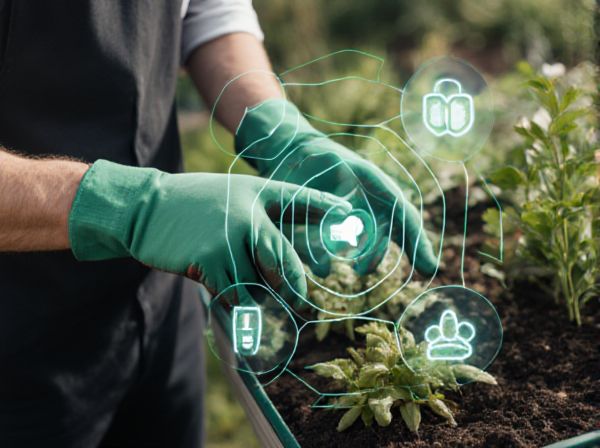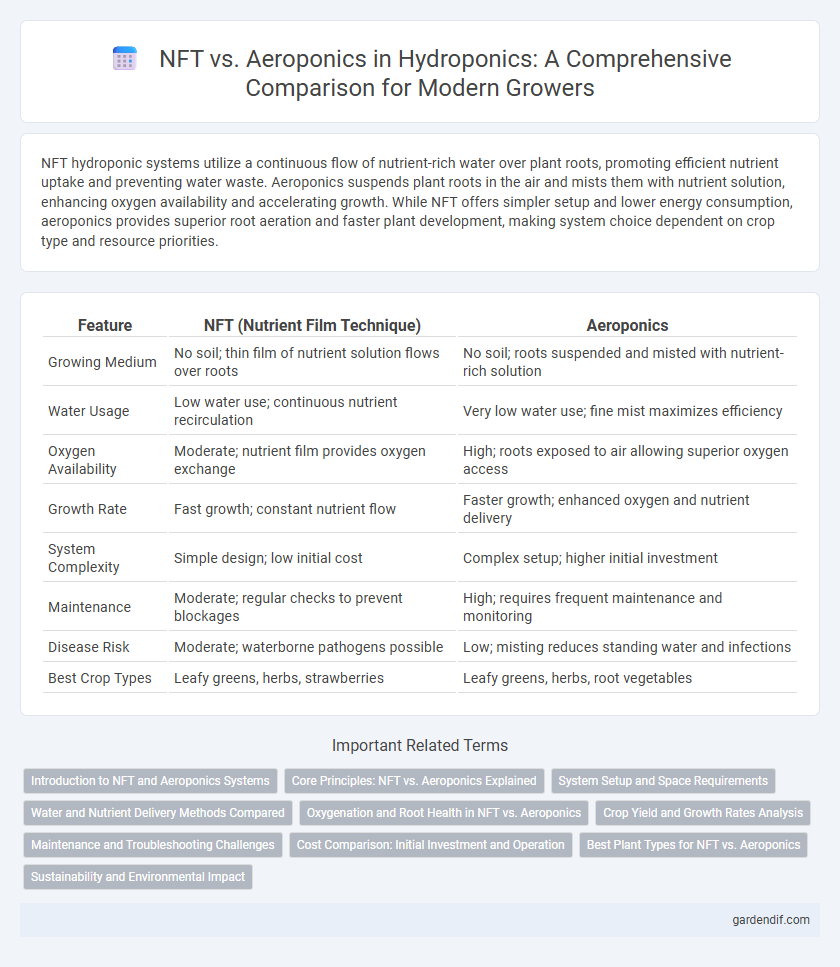
NFT vs Aeroponics Illustration
NFT hydroponic systems utilize a continuous flow of nutrient-rich water over plant roots, promoting efficient nutrient uptake and preventing water waste. Aeroponics suspends plant roots in the air and mists them with nutrient solution, enhancing oxygen availability and accelerating growth. While NFT offers simpler setup and lower energy consumption, aeroponics provides superior root aeration and faster plant development, making system choice dependent on crop type and resource priorities.
Table of Comparison
| Feature | NFT (Nutrient Film Technique) | Aeroponics |
|---|---|---|
| Growing Medium | No soil; thin film of nutrient solution flows over roots | No soil; roots suspended and misted with nutrient-rich solution |
| Water Usage | Low water use; continuous nutrient recirculation | Very low water use; fine mist maximizes efficiency |
| Oxygen Availability | Moderate; nutrient film provides oxygen exchange | High; roots exposed to air allowing superior oxygen access |
| Growth Rate | Fast growth; constant nutrient flow | Faster growth; enhanced oxygen and nutrient delivery |
| System Complexity | Simple design; low initial cost | Complex setup; higher initial investment |
| Maintenance | Moderate; regular checks to prevent blockages | High; requires frequent maintenance and monitoring |
| Disease Risk | Moderate; waterborne pathogens possible | Low; misting reduces standing water and infections |
| Best Crop Types | Leafy greens, herbs, strawberries | Leafy greens, herbs, root vegetables |
Introduction to NFT and Aeroponics Systems
NFT (Nutrient Film Technique) systems circulate a thin film of nutrient-rich water over plant roots, allowing efficient oxygenation and nutrient absorption in hydroponic setups. Aeroponics suspends plant roots in the air and continuously mists them with nutrient solution, enhancing oxygen availability and promoting rapid plant growth. Both systems optimize nutrient delivery but differ in root exposure and environmental control, impacting crop yield and resource efficiency.
Core Principles: NFT vs. Aeroponics Explained
Nutrient Film Technique (NFT) hydroponics circulates a thin film of nutrient solution over plant roots within a sloped channel, providing constant access to water, oxygen, and nutrients. Aeroponics suspends roots in air and intermittently mists them with nutrient-rich water, maximizing oxygen exposure and promoting rapid nutrient absorption. Both methods optimize root aeration and nutrient delivery but differ in water usage, oxygen availability, and system complexity, influencing plant growth rates and maintenance requirements.
System Setup and Space Requirements
NFT hydroponic systems use a continuous flow of nutrient-rich water over plant roots in shallow channels, requiring less vertical space and simpler setup with pumps and channels. Aeroponics systems suspend plant roots in air and mist them with nutrient solution, demanding more complex infrastructure, including misting nozzles and high-pressure pumps, but optimizing oxygen availability to roots. Space-wise, NFT systems are more compact horizontally, while aeroponics benefit from vertical stacking, making them suitable for limited floor areas but with greater height clearance.
Water and Nutrient Delivery Methods Compared
NFT (Nutrient Film Technique) uses a continuous, thin film of nutrient-rich water flowing over plant roots, ensuring constant hydration and nutrient absorption. Aeroponics delivers nutrients by misting the roots with a fine aerosol, maximizing oxygen exposure and enhancing nutrient uptake efficiency. Both methods optimize water use, but aeroponics reduces water consumption further by minimizing runoff and improving nutrient delivery precision.
Oxygenation and Root Health in NFT vs. Aeroponics
NFT systems supply a continuous flow of nutrient-rich water over plant roots, ensuring moderate oxygenation but potentially limiting gas exchange compared to aeroponics. Aeroponics delivers roots suspended in air with fine nutrient mist, maximizing oxygen exposure and promoting superior root respiration and health. Enhanced oxygen availability in aeroponics supports faster nutrient uptake and reduces root diseases relative to the more water-submerged roots in NFT setups.
Crop Yield and Growth Rates Analysis
NFT (Nutrient Film Technique) systems provide consistent nutrient flow over plant roots, resulting in moderate growth rates and reliable crop yields suitable for leafy greens and herbs. Aeroponics delivers nutrient-rich mist directly to roots, significantly enhancing oxygen availability, which accelerates growth rates by up to 25% and potentially increases crop yields by 20-30% compared to NFT. Both systems optimize nutrient delivery, but aeroponics generally outperforms NFT in maximizing production efficiency and growth speed.
Maintenance and Troubleshooting Challenges
NFT hydroponic systems require regular monitoring of nutrient film flow and pump functionality to prevent root suffocation and clogging, posing moderate maintenance challenges. Aeroponics demands meticulous upkeep of misting nozzles and air circulation systems to avoid root drying and bacterial growth, making troubleshooting more complex and time-sensitive. Both systems benefit from preventive maintenance protocols, but aeroponics often involves higher technical skill to resolve frequent nozzle blockages and ensure optimal root oxygenation.
Cost Comparison: Initial Investment and Operation
NFT (Nutrient Film Technique) systems generally require a lower initial investment due to simpler infrastructure and fewer components compared to aeroponics, which involves more advanced spraying technology and precise environmental control systems. Operating costs for NFT are typically reduced by lower energy consumption and less frequent maintenance, while aeroponics demands higher energy input to power misting pumps and specialized equipment, increasing ongoing expenses. Despite higher upfront and operational costs, aeroponics often yields faster growth rates and higher crop density, potentially offsetting the cost differential over time.
Best Plant Types for NFT vs. Aeroponics
NFT systems excel with leafy greens such as lettuce, spinach, and herbs due to their steady nutrient flow and shallow root support. Aeroponics suits plants requiring improved oxygenation like strawberries, tomatoes, and root vegetables, promoting faster growth and higher yields. Understanding plant-specific oxygen and moisture needs directs optimal system choice between NFT and aeroponics.
Sustainability and Environmental Impact
NFT hydroponic systems use a continuous nutrient film to deliver water and nutrients, reducing water waste and energy consumption compared to traditional agriculture. Aeroponics maximizes sustainability by misting plant roots with nutrient-rich solutions, significantly lowering water usage by up to 90% and minimizing soil erosion and runoff pollution. Both technologies support sustainable farming, but aeroponics offers superior water efficiency and reduced environmental impact through its soil-less, mist-based nutrient delivery.
NFT vs Aeroponics Infographic

 gardendif.com
gardendif.com